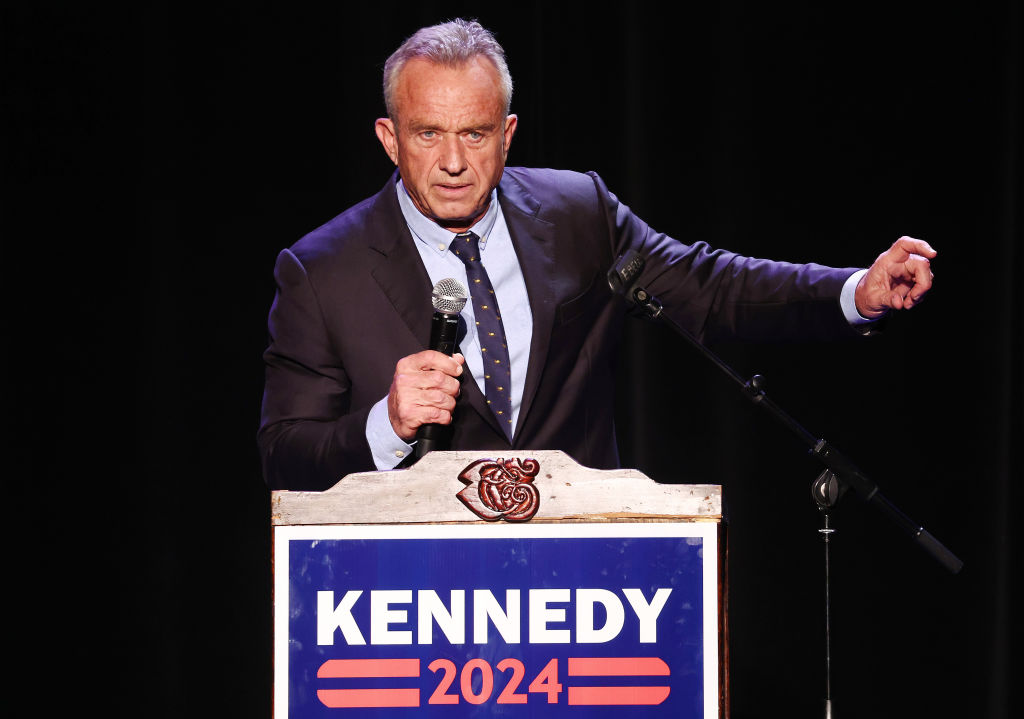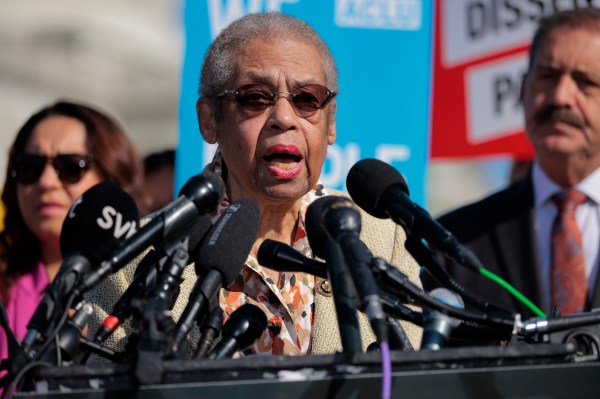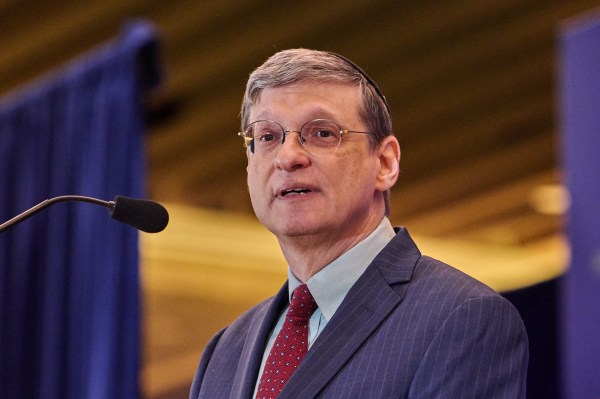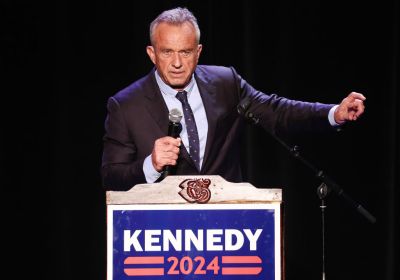Imagine walking into the voting booth on November 5 next year and scanning down the list of presidential candidates. There’s President Joe Biden, Democrat; Donald Trump, Republican. The Libertarian and Green parties likely will have their own candidates in your state. And you could spot a few other minor party candidates whose names you’ll have seen for the first time that day. So far, pretty normal.
Now imagine seeing additional names you recognize from their TV ads, campaign rallies, or perhaps from the presidential debates: Independent candidate Robert F. Kennedy Jr.? A No Labels candidate such as Larry Hogan or Joe Manchin, or someone else with centrist credentials?
It’s not just plausible but probable one or both of those lines will be on the ballot. And if you’re one of the 52 percent of registered voters who told Quinnipiac last month that they would like additional candidates to enter the race, you can imagine joining millions of Americans in voting for someone not named Biden or Trump. If today’s polling holds true for 11 months, they’d be two of the least popular candidates in recent memory—Biden with growing concerns about his advanced age and poor job approval, Trump with his numerous indictments and refusal to concede the 2020 election.
Now let’s imagine a harder-to-fathom scenario: With other candidates in the field, neither Trump nor Biden wins the 270 electoral votes for a majority. As outlined in the Constitution, election of the head of the executive branch would suddenly be in the hands of Congress, specifically the Congress elected next November. In the House, each state’s delegation would receive one vote to allocate among the top two or three performing candidates in the Electoral College. The Senate would choose, by majority vote, the vice president among the top two performing vice presidential candidates.
It sounds crazy—the sort of chaos that makes for compelling TV drama or an outlandish political fantasy. But you’d best start believing in fantasy scenarios: You’re in one. With the two major-party presidential candidates being historically unpopular, the 2024 election is already bucking convention. And there is precedence for unpredictability, including the realignment election of 1824, the last time a president was selected by the incoming members of the House of Representatives.
Whether things go that far remains to be seen. But Frank Luntz, the pollster who has conducted research for No Labels, told The Dispatch that the market is there for someone other than Trump and Biden.
“More than half the country desperately wants an alternative,” said Luntz.
First things first: Getting on the ballot.
Any viable alternative candidate to the Democratic and Republican nominees needs to overcome the most significant barrier to entry: ballot access.
Getting on the ballot without the benefit of being a major-party nominee means navigating the patchwork of rules, requirements, and deadlines across the country’s states and territories. Some states have relatively easy requirements, sometimes as simple as a petition signed by 1,000 registered voters. Other states’ petitions require thousands more signatures, with specific thresholds for each congressional district or county. Some require a complete ticket, with a named presidential candidate and running mate, to apply for ballot access. Many require independent or unaffiliated candidates to provide a specific slate of certified electors when they file their paperwork. Depending on the state, an aspiring independent candidate may need to fulfill a combination of these requirements, and only within a prescribed period of time that can be as short as a week.
Meeting all those requirements is the tough grunt work of an independent bid, but No Labels leaders are confident they’ve done as much as anyone to set up a presidential candidate for success. The 13-year-old political group has long sought to organize and activate what it has claimed is a robust bipartisan centrist majority. (The most lasting achievement of No Labels so far is inspiring the 2017 creation of the Problem Solvers Caucus, a bipartisan group in the House of Representatives that has gotten more attention for its infighting and lack of unity than for any legislative efforts.) But No Labels has turned its focus toward supporting an independent presidential candidate.
“We think an independent could win the White House,” said Ryan Clancy, the chief strategist for No Labels, in an interview with The Dispatch. “We have spent two years planning for this.”
The clock is ticking: The first deadline for fulfilling the requirements as an independent candidate is January 8 in Utah. Clancy and his team know the menu and schedule of ballot-access requirements and claim to already be on the ballot in 12 states. There are 22 additional states with deadlines in the early part of 2024 where No Labels is already working to get access by the middle of spring 2024, said Clancy. For the remaining 16 states and the District of Columbia, the plan is to hand the ballot-access responsibilities to the campaign of the designated No Labels ticket, since many of those states have both later deadlines and require named candidates to get on the ballot.
But getting on the ballot won’t mean much if No Labels can’t decide on a candidate. Clancy said the group is not ready to lay out the details of its selection process. The long-held plans to hold a No Labels nominating convention in Dallas this May were recently scrapped in favor of a “virtual process.”
“We will have more details on our selection process early next year and look forward to hearing the views of our community on who they want to see on our Unity ticket in 2024,” said No Labels in a statement late last month.
The starting point for selecting a No Labels candidate is its centrist policy manifesto, a 30-point plan of ideas called “Common Sense.” But it’s not an ironclad platform, according to Clancy. Indeed, the plan’s proposals are often vague enough to give whichever candidate is selected plenty of wiggle room to tailor it to their own specific preferences. Idea 10, which states that “Americans have a constitutional right to own guns, but society also has a responsibility to keep dangerous weapons away from dangerous people,” is typical of No Labels’ split-the-baby approach.
But who earns the group’s nod is still a live question. Two co-chairs of the group (largely ceremonial positions) have teased the idea of running for president themselves: former Maryland Gov. Larry Hogan, a Republican, and Democratic Sen. Joe Manchin of West Virginia. Other possibilities could be Sen. Mitt Romney of Utah or former Rep. Liz Cheney of Wyoming, both Republicans who have become estranged from their party over Trump. Clancy says the group has spoken with multiple potential candidates but declined to provide any names to The Dispatch.
Finding a candidate isn’t a problem for Robert F. Kennedy Jr. whose campaign, like No Labels, claims to have a systematic plan for getting on the ballot in every state and the District of Columbia.
“We have a very robust ballot-access team,” said Stefanie Spear, the Kennedy campaign’s communications director. “We are very organized and strategic.”
Spear outlined how the team has broken every state into four “tiers” based on the difficulty or nature of the requirements for getting on the ballot as an independent. Kennedy has scheduled rallies in the various states where he can already begin collecting signatures, including a recent event in Utah and upcoming rallies in Nebraska and Missouri later this month. When asked whether Kennedy was in talks with any minor parties already on the ballots in some states about seeking those parties’ nominations, Spear dismissed the idea.
“We are running as an independent. We are not in current conversations with other parties,” she said.
If Kennedy, a No Labels candidate, and any other independent challengers emerge with ballot access and significant national support—Luntz told The Dispatch he has seen evidence a centrist No Labels candidate could begin the race with 20 percent of the vote—the unpredictability of the 2024 election could extend to the Electoral College.
The potential for Electoral College chaos
It takes 270 of the 538 electoral votes to win a majority and the presidency.* Even one credible challenger to Biden and Trump could deny them both that majority—but you have to reach far back into American history to find the last time that happened.
Third party candidates have won electoral votes in the past. The most recent to do so was George Wallace in 1968, when the segregationist protest candidate scooped up 46 electoral votes as Republican Richard Nixon notched a landslide victory. In 1992, independent Ross Perot won 19 percent of the popular vote, the high-water mark for an independent or third-party presidential candidate in the last century. But Perot didn’t win a single electoral vote, and Democrat Bill Clinton won a electoral-vote majority with a plurality of the popular vote.
Plenty of other presidential elections have taken unconventional turns: The popular vote winners of the 1876, 1884, 2000, and 2016 elections all lost the Electoral College, sometimes thanks to third-party protest candidates. The 1912 election saw a former president, Teddy Roosevelt, launch his own third-party bid and draw votes away from incumbent Republican William Howard Taft to deliver a clear electoral victory for the Democrat, Woodrow Wilson.
But to find a parallel to the most chaotic scenario for 2024—with no candidate winning a majority of electoral votes and the House holding its own contingent election—occurred exactly 200 years ago, during the disputed 1824 election. Back then, there were four major candidates, each of whom won at least three states in the 24-state union. That was enough to deny Andrew Jackson, the winner of a plurality of the popular vote and the most electoral votes, a majority in the Electoral College. Placing second and third were John Quincy Adams and William Crawford, but Jackson’s victory seemed all but assured, a reflection of the popular will that would be confirmed by the people’s house in Congress.
But things went sideways when the decision went to the House, where the winner needed to take 13 state delegations—offering a warning for how messy a parallel situation could be in our own time.
The last of the four candidates, Henry Clay, was eliminated from the contingent election, though as speaker of the House, he remained an unusually powerful force in the election. Clay, a reformer opposed to slavery, hated Jackson and was more ideologically aligned with Adams than the conservative Crawford. These politics helped drive the surprising outcome that Jackson partisans would dub the “Corrupt Bargain.”
With Clay’s help, Adams won support from the delegations from many more states, including three that Clay had won in November and three that Jackson had won. It was enough to send Adams, not Jackson, to the White House. One of his first acts as president, by the way, was appointing Clay secretary of state.
The conditions for the 1824 election were vastly different than our own two centuries later. In 1824, the country was emerging from a period of broad political unity, with the presidential election presaging the factionalism that would define American politics up to the Civil War. The confusing results in 1824 were in no small part thanks to the fact that all four candidates ostensibly hailed from the same party, yet their regional and ideological differences were vast. The westward expansion of American territory and the issue of slavery have no clear parallels to our moment.
Yet the unpredictability of 1824, and the political fallout—an angry Jackson helped launch the modern Democratic Party and rode a nascent populist wave four years later to defeat Adams—may help to expand our own understanding of what is possible in 2024.
Upending the system.
Of course, there are limits to what’s possible, starting with a lack of imagination. The two-party system has been so dominant and enduring that it can be a hurdle to conceive of how anyone could break the duopoly.
But often, the interloper candidates will compound the idea that the presidential election is a binary choice by either drawing primarily from one of the two major parties or failing to make a meaningful impact where it really counts, in the Electoral College. Perot’s flightiness in 1992—dropping out of the race in July only to rejoin in October—killed his credibility. In 1968, Wallace’s segregationist views limited his ability to carry states outside of Georgia, Alabama, Mississippi, Louisiana, and Arkansas.
There is palpable concern about an independent helping Trump by splitting the anti-Trump vote with Biden, including among possible candidates. A person close to Larry Hogan, for instance, says the former Maryland governor is skeptical about a third party bid succeeding. And it’s an issue of concern for Liz Cheney as she says she continues to think about her own potential presidential run.
“I haven’t made a decision, yet, about what I’m going to do next year,” she said on a recent episode of The Dispatch Podcast. “I think the fact that people are talking about and thinking about third parties, whether it’s me or anybody else, tells you how much, sort of, the tectonic plates of our politics have shifted.”
No Labels maintains that if its eventual candidate looks to be “spoiling” the race and handing it to Trump—a charge Clancy says liberal critics of the group are making without any evidence—the group can renege on its plans altogether.
“There’s a world in which we don’t offer our ballot line to a ticket,” Clancy told The Dispatch.
And although he began his campaign as a Democratic challenger to Biden, Kennedy’s conspiratorial views have drawn support from a wide range of people with differing political views, including Republican-leading populists. Florida Gov. Ron DeSantis even suggested that if elected president he’d ask Kennedy to join his administration as part of a “task force” to “hold people accountable” for the government’s response to the COVID-19 pandemic. There’s reason to think a robust Kennedy campaign would function less like a left-wing protest—the way Democrats fear leading Green party candidate Jill Stein could pull votes from Biden and boost Trump—and more like a populist wild card who could dilute support from both major-party nominees. The outcome of a strong Kennedy bid is particularly hard to game out at this point.
And even if a third, independent candidate holds both Biden and Trump below the 270-electoral vote threshold, the chaos only ramps up. A contingent election in the House of Representatives would be called immediately after the counting of the electoral votes. At the moment, the breakdown of House delegations would seem to give the advantage to the Republican, since the GOP has the majority in the House delegations in 26 states while Democrats have the majority in just 22 state delegations, with two state delegations, Minnesota’s and North Carolina’s, evenly split between the two parties.
But a contingent presidential election in January 2025 would be taken among the newly sworn-in House members, meaning those elected in November 2024—all of which gives the House races renewed importance. And while our assumptions about hyperpartisanship suggests state delegations will stick with their party’s nominees, the introduction of a third candidate into the mix—especially a centrist with appeal to those few crucial moderate House members in both parties—could make for some unpredictable political jockeying. Oh, and one more thing: With the vice president in a contingent election being selected by a simple majority in the Senate, it’s possible Congress would elect a president and vice president from different tickets.
Whether some or any of these unprecedented events actually takes place will depend on factors within and without the control of these groups, organizations and individuals. Joe Biden could have a change of heart over Christmas and announce in January that he is no longer seeking reelection. Trump’s legal battles could do significant damage to his political viability once his criminal trials begin or if he’s convicted of a felony. Either of these elderly men could become incapacitated or even die before Election Day. An economic boom or bust could alter Biden’s approval rating. No Labels could decide against fielding a candidate—or its candidate could fail to gain any traction with the larger public. The same could go for Kennedy.
But what is clear is that the menu of plausible outcomes for the 2024 presidential election is perhaps wider than it’s been in recent memory—a reflection of significant dissatisfaction with where the two major parties appear to be heading.
“People want results, and they feel they haven’t gotten them from either side,” said Luntz. “Our political system is not working.”
Correction, December 14, 2023: There are a total of 538 electoral votes up for grabs in a presidential election, not 535 as this article previously stated.







Please note that we at The Dispatch hold ourselves, our work, and our commenters to a higher standard than other places on the internet. We welcome comments that foster genuine debate or discussion—including comments critical of us or our work—but responses that include ad hominem attacks on fellow Dispatch members or are intended to stoke fear and anger may be moderated.
With your membership, you only have the ability to comment on The Morning Dispatch articles. Consider upgrading to join the conversation everywhere.